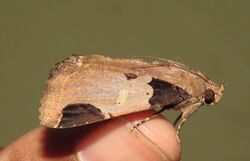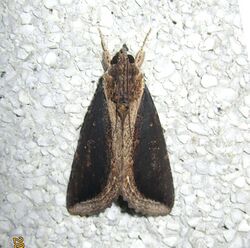Biology:Ercheia cyllaria
| Ercheia cyllaria | |
|---|---|

| |
| Male | |

| |
| Female | |
| Scientific classification | |
| Domain: | Eukaryota |
| Kingdom: | Animalia |
| Phylum: | Arthropoda |
| Class: | Insecta |
| Order: | Lepidoptera |
| Superfamily: | Noctuoidea |
| Family: | Erebidae |
| Genus: | Ercheia |
| Species: | E. cyllaria
|
| Binomial name | |
| Ercheia cyllaria (Cramer, 1779)[1]
| |
| Synonyms | |
| |
Ercheia cyllaria is a species of moth of the family Erebidae first described by Pieter Cramer in 1779. It is found in the India , Sri Lanka, Taiwan,[2] Japan , Indochina, Thailand, Peninsular Malaysia, Sumatra, Borneo, Seram and the Kai Islands.
Description
Its head, thorax and forewings are pale reddish brown. The collar and patagia are often streaked with black. Forewings with indistinct, waved antemedial line and a very much excurved postmedial line beyond the cell. A waved sub-marginal line is present. Orbicular is a speck and reniform is indistinctly dark outlined. Abdomen and hindwings fuscous black. Hindwings with three medial white spots, which may be disconnected and the costal spot obsolescent or conjoined into a band. A spot near center of outer margin. Cilia white at apex and outer angle. Ventral side ochreous white, irrorated (sprinkled) with black. Forewings with oblique crenulate postmedial line and broad sub-marginal diffused band. Hindwings similar, but with a lunule at end of cell and the line more irregular. Colours and spots can vary in subspecies.[3]
The larvae feed on Asparagus, Brassica, Dalbergia and Grewia species.[4]
References
| Wikimedia Commons has media related to Ercheia cyllaria. |
- ↑ Yu, Dicky Sick Ki. "Ercheia cyllaria (Cramer 1779)". Taxapad. http://www.taxapad.com/local.php?taxonidLC=86002855. Retrieved January 14, 2019.
- ↑ "Ercheia cyllaria 曲耳裳蛾". Ercheia cyllaria 曲耳裳蛾. http://dearlep.tw/species.html?namecode=346255.
- ↑ Hampson, G. F. (1894). The Fauna of British India, Including Ceylon and Burma: Moths Volume II. Taylor and Francis. https://www.biodiversitylibrary.org/item/180400#page/5/mode/1up.
- ↑ "Ercheia cyllaria Cramer". Ercheia cyllaria Cramer. http://www.mothsofborneo.com/part-15-16/ercheiini/ercheiini_1_3.php.
Wikidata ☰ Q5385188 entry
 |

